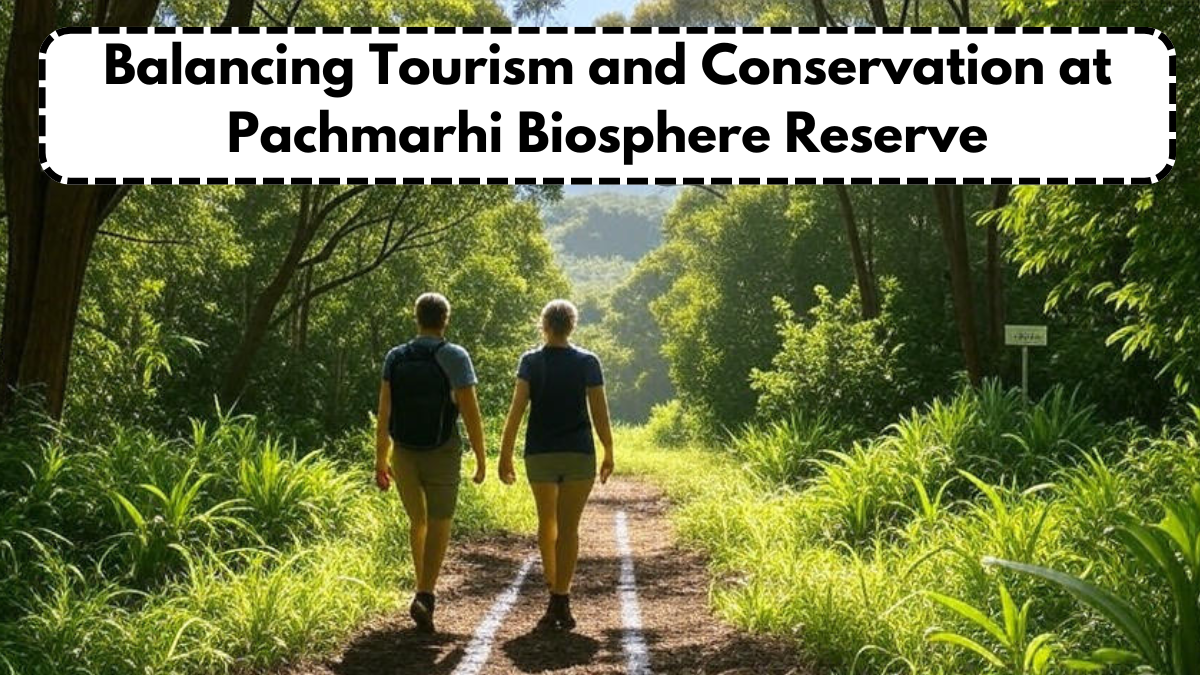Nestled in the Satpura mountain range of Madhya Pradesh, the Pachmarhi Biosphere is one of India’s most unique ecological treasures. Known for its rich biodiversity, dense forests, waterfalls, and cultural significance, the reserve attracts thousands of visitors every year. Yet, as tourism grows, so does the challenge of preserving its delicate ecosystem. Striking the right balance between conservation and economic benefits has become a central issue for policymakers, local communities, and environmentalists.
The importance of this balance cannot be overstated. On one hand, tourism brings revenue, employment, and cultural recognition. On the other, unchecked activities threaten wildlife, forests, and water resources. That is where the concept of sustainable tourism becomes vital, ensuring that human activities coexist harmoniously with nature.

The Ecological Importance of Pachmarhi Biosphere
The Pachmarhi Biosphere Reserve is recognized by UNESCO as part of its network of biosphere reserves. Spanning over 4,900 square kilometers, it is home to diverse flora and fauna, including tigers, leopards, bison, and several endemic plant species. The region’s forests also support tribal communities who depend on natural resources for their livelihood.
From a conservation perspective, Pachmarhi plays a crucial role in maintaining ecological balance in central India. Its rivers and forests act as lifelines for surrounding regions, while its biodiversity contributes to global environmental health. Protecting such areas is therefore essential not just for India, but for the world. The integration of sustainable tourism offers a way to preserve this ecological wealth while still promoting development.
The Role of Tourism in Pachmarhi
Tourism in the Pachmarhi Biosphere has expanded rapidly in recent decades. Visitors are drawn to its waterfalls, viewpoints, caves, and cultural landmarks. Local communities have benefitted through jobs in hospitality, guiding, and handicrafts. Tourism also raises awareness about the reserve’s ecological and cultural value.
Here’s a comparison of tourism’s impacts:
| Impact Area | Positive Effects | Negative Effects |
|---|---|---|
| Economy | Job creation, local income growth | Seasonal dependence on tourism |
| Environment | Awareness about biodiversity | Pollution, littering, habitat disturbance |
| Community | Skill development, cultural promotion | Cultural commercialization, rising costs |
This table demonstrates the double-edged nature of tourism. While it supports development, without sustainable tourism practices, it risks damaging the very environment that attracts visitors in the first place.
Sustainable Tourism Practices in Pachmarhi
To protect the Pachmarhi Biosphere, sustainable tourism practices are being encouraged. These include regulating visitor numbers, promoting eco-friendly accommodations, and ensuring waste management. Nature trails and eco-camps are designed to minimize disturbance to wildlife, while community-based tourism empowers locals to act as custodians of their environment.
Efforts also focus on educating tourists about responsible behavior. Visitors are encouraged to avoid plastic, respect wildlife, and contribute to conservation initiatives. These practices align with the principles of sustainable tourism, creating a model where economic development and environmental protection go hand in hand.
Challenges to Conservation
Despite these efforts, challenges persist. Illegal logging, poaching, and unregulated construction threaten the Pachmarhi Biosphere. Tourist inflows sometimes exceed carrying capacity, straining resources like water and waste management systems. Moreover, climate change adds new risks, including unpredictable rainfall patterns and forest degradation.
The success of sustainable tourism depends on effective enforcement, community participation, and long-term planning. Without these, short-term gains from tourism could result in irreversible ecological losses.
Conclusion
The Pachmarhi Biosphere is both a natural wonder and a living example of the need to balance human activity with environmental protection. Tourism has the potential to bring prosperity, but only if guided by the principles of sustainable tourism. By fostering community involvement, enforcing regulations, and educating visitors, Pachmarhi can remain a model of harmony between conservation and development. Protecting this treasure today will ensure that future generations can continue to experience its beauty and biodiversity.
FAQs
Why is Pachmarhi Biosphere important?
It is a UNESCO-recognized reserve rich in biodiversity, home to unique species and vital ecosystems in central India.
How does tourism affect Pachmarhi Biosphere?
Tourism brings income and awareness but also risks such as pollution, habitat disturbance, and cultural commercialization.
What is sustainable tourism in Pachmarhi?
It involves eco-friendly practices like regulated visitor flows, waste management, and community-based initiatives to protect biodiversity.
How can visitors contribute to conservation in Pachmarhi?
By following eco-friendly guidelines, avoiding plastic, respecting wildlife, and supporting local community initiatives.
Click here to learn more.
Pari is a passionate writer known for captivating stories that blend imagination and reality. Inspired by travel, history, and everyday moments, Pari crafts narratives that resonate deeply with readers.